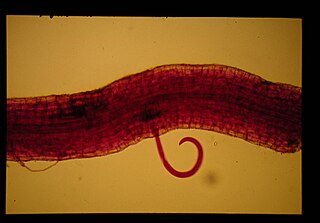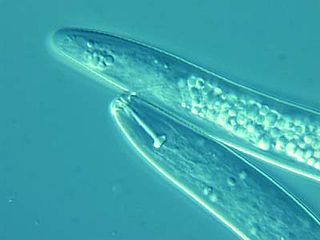Related Research Articles
Paratrichodorus minor is a species of nematode in the family Trichodoridae, the stubby-root nematodes. It occurs in tropical and subtropical regions of the world. It damages plants by feeding on the roots and it is a vector of plant viruses. It is a pest of some agricultural crops.

Pratylenchus penetrans is a species of nematode in the genus Pratylenchus, the lesion nematodes. It occurs in temperate regions worldwide, regions between the subtropics and the polar circles. It is an animal that inhabits the roots of a wide variety of plants and results in necrotic lesions on the roots. Symptoms of P. penetrans make it hard to distinguish from other plant pathogens; only an assay of soil can conclusively diagnose a nematode problem in the field. P. penetrans is physically very similar to other nematode species, but is characterized by its highly distinctive mouthpiece. P. penetrans uses its highly modified mouth organs to rupture the outer surface of subterranean plant root structures. It will then enter into the root interior and feed on the plant tissue inside. P. penetrans is considered to be a crop parasite and farmers will often treat their soil with various pesticides in an attempt to eliminate the damage caused by an infestation. In doing this, farmers will also eliminate many of the beneficial soil fauna, which will lead to an overall degradation of soil quality in the future. Alternative, more environmentally sustainable methods to control P. penetrans populations may be possible in certain regions.
Pratylenchus vulnus is a species of plant pathogenic nematode best known for infecting Persian walnut. It is also known to infest potatoes, apricots, peaches and nectarines, holiday cacti, grape and citruses.

Helicotylenchus dihystera is a plant pathogenic nematode. It is known to inhabit sugarcane, rice, potatoes, corn, peanut, millet, sorghum, banana and forest trees.
Heterodera gambiensis is a plant pathogenic nematode affecting pearl millet.
Hoplolaimus columbus is a plant pathogenic nematode.
Hoplolaimus magnistylus is a plant pathogenic nematode affecting soybeans.
Hoplolaimus pararobustus is a plant pathogenic nematode.
Hoplolaimus seinhorsti is a plant-pathogenic nematode affecting pigeon pea.
Pratylenchus mulchandi is a plant pathogenic nematode infecting pearl millet.
Tylenchorhynchus phaseoli is a plant pathogenic nematode infecting pearl millet.
Tylenchorhynchus vulgaris is a plant pathogenic nematode infecting pearl millet.
Tylenchorhynchus zeae is a plant pathogenic nematode infecting pearl millet.

Pratylenchidae is a family of plant pathogenic nematodes.

Hoplolaimidae is a family of plant pathogenic nematodes. It has two subfamilies, Hoplolaiminae and Rotylenchulinae. Typically hoplolaimids are ecto- or semi endoparasites of higher plants.
H. indicus may refer to:
Hoplolaimus galeatus is a plant pathogenic nematode.
Heliothrips indicus is a species of thrips. It is a pest of millets such as on finger millet, sorghum, and pearl millet in India.
Tanymecus indicus is a species of weevil. It is a pest of millets such as pearl millet and sorghum in India.